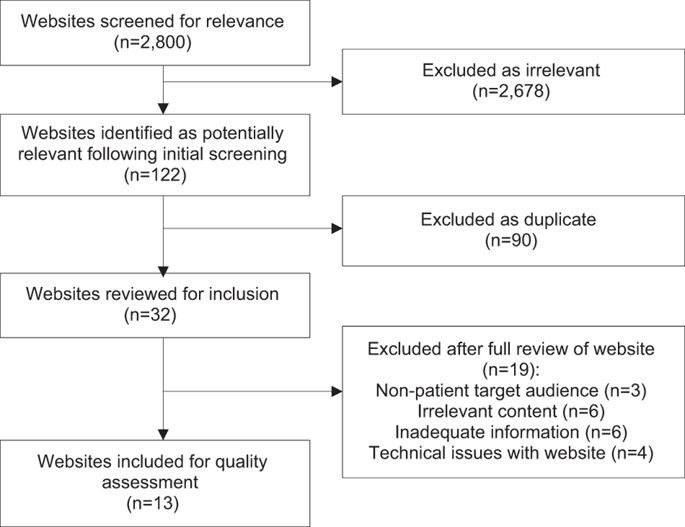This research used mixed methods to identify and evaluate the quality of information for people with hypodontia that is provided by dental professionals and available on the Internet. The findings show there is considerable variability in the provision and quality of written information. This is consistent with studies in other areas of dentistry, where variability in comprehensiveness, transparency and readability were common problems.4–10 Challenges to information provision are likely to be compounded for interdisciplinary conditions such as hypodontia, where information needs to cover a range of complex interventions. No previous studies were identified that assessed provision of patient information in similar interdisciplinary areas of dentistry to enable comparison. One study assessing patient knowledge of dental implants found dentists are still the main source of information,22 a finding supported by a study measuring information-seeking in orthodontic patients.23 Interestingly the latter study, undertaken in 2013, found Internet use was low (8%).
Dental professionals recognised a need to provide better quality written information to support people with hypodontia. The quality assessment indicated most resources focused on information to prepare people for a consultation or specific procedure. No resources used techniques known to increase lay understanding or encourage evaluation of patient values and reasoning about treatment in the context of their lives. These findings imply current information provision is unlikely to improve dental literacy or support dental professionals in engaging their patients in making informed decisions about their care.
The study findings have informed specific recommendations for future improvements to resources to make information more patient-centred (Table 8). Information resources need to be clear in their purpose and target audience to ensure the content is sufficiently comprehensive to fulfil this role. The content of these patient resources described factors that dental service providers see as essential in patient care. Certainly, the suggestions for improving patient resources offered by the dental professionals focused on more comprehensive clinical information about treatment, with little emphasis on experience of care and quality of life. It is likely that the ‘professionalisation’ that occurs during training moves people from layperson to dental expert leading to changes in perception of the impact of oral symptoms, treatment needs and access to care.3 Patient information resources aim to address the inequality in professional and lay understanding of health conditions, but to do this, appreciation of the how people think about dental health and experience hypodontia and its management is essential. Adopting a co-production approach with people affected by hypodontia before and during the design of information reosurces may help address some of the limitations of current resources.
Future patient resources should consider incoporating tools that have been shown to proactively support better thinking by patients and enhance health literacy, treatment decision making and engagement with care (see DISCERN19 and IPDAS20). Guidance highlights how clinicians can make information balanced, non-directive and able to support people to consider their own values and preferences for treatment.24 Images and visual aids have a role in helping people understand numerical data, processes and technical procedures for those with low literacy.25 However, there is little evidence that dental images facilitate engagement, understanding, decision making, and adherence. It may be that in this clinical context, dental images may trigger an adverse emotional response and patient reaction.26,27
The increasing availability and use of multimedia and online information in health care is likely to continue changing how patients access information in the future. No respondents indicated use of a tablet device to share information but this is a potential future development, alongside information provision via mobile telephone apps. A randomised controlled trial is in progress in the UK to determine whether a patient information app for hypodontia will make patients better informed and more satisfied with the consultation process.28 Online information has scope for increasing the amount of information available while enabling tailoring for different severities and presentations of conditions and different treatment options. With this potential abundance of information it is essential that authorship and affiliations are transparent, information sources are cited to demonstrate credibility and information is kept up to date. In addition, there is an opportunity to develop components of information that are associated with better dental literacy and engagement with hypodontia management.
The survey successfully identified a number of resources that were unknown to the authors and although inclusion of resources for quality assessment was not exhaustive, it is unlikely inclusion of further resources would significantly affect the overall conclusions of the study. The response rate from the survey was relatively low (49%) although this is concordant with other postal surveys. There did not appear to be a systematic difference between responders and non-responders. It is unlikely that the results would have been significantly changed by a higher responses rate, as there was evidence of agreement in the opinions of the dentist groups. Only one questionnaire was sent to each respondent so for clinicians working in both primary care and secondary care settings there was little scope to differentiate between information provision in each care setting. This may have led an erroneous assumption that information provision was the same for clinicians across different settings.
The quality assessment tool was informed by established methods of assessing information quality and although not validated, it enabled systematic elicitation of information to enable a synthesis of current resources. The scope of this study was limited to information gathering and opinion from a dental professional perspective only. The findings from all three analyses suggest confidence in our findings that current resources are not able to boost patients’ thinking about hypodontia care and management.


